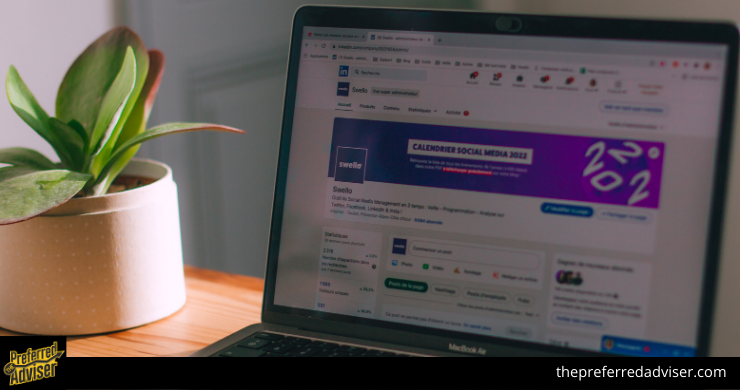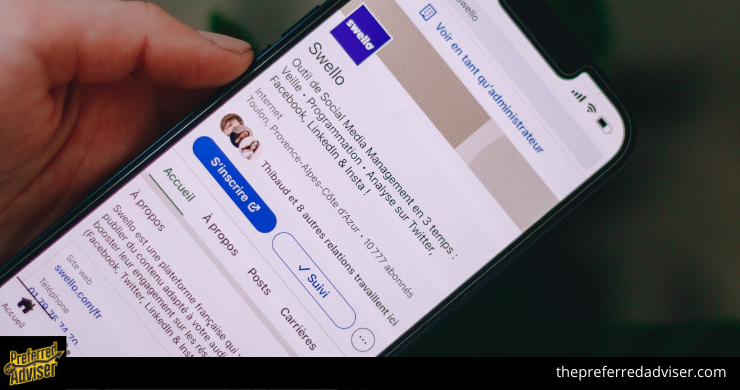Even though social media plays such a big role in our lives, most financial advisers I talk to haven’t taken advantage of social media marketing to grow their businesses.
Many people are not using social media because they do not know how to use it.
In this article, you will know how IFAs and other financial advisers can use LinkedIn to generate leads. LinkedIn can be used to connect with individuals and businesses that are looking for financial advice.
While LinkedIn shares some similarities with other social media networks, it sets itself apart by catering primarily to professionals and businesses.
How does LinkedIn work for IFA’s
LinkedIn is a social media platform that lets you connect with other users, such as other professionals or potential clients. LinkedIn is similar to other social media platforms in that way.
Once you have made some LinkedIn connections, you can maintain those relationships by posting interesting content on LinkedIn for others to see, sending direct messages to them, or commenting on posts they have made.
LinkedIn considers the people you are directly connected to as your first-degree connections.
A 2nd degree connection is someone who is not connected to you directly, but is connected to one of your connections.
Someone who is not connected to you, but is connected to one of your 2nd degree connections, is a 3rd degree connection.
This model is based on the principle that everyone on Earth is six or fewer steps away from any other person.
LinkedIn is a business networking site that has more information about its members’ professions, employers, and skills than the other social networks.
1. Change Your Boring LinkedIn Headline
I often see headlines that say “Financial Advisor at XYZ Financial.” While it’s great that this is someone’s title and company, it doesn’t say anything about the people they serve, what they do, or how someone can benefit from their services.
When crafting a perfect headline, you should focus on your services, your target market, and how you can help them. When I first started The Advisor Coach, my headline was, “I Get Financial Advisors More Clients.” My services help advisors get more clients, which in turn makes them more money. It’s simple math.
Test out these good headlines for financial advisors:
- “Certified Financial Planner Helping Divorcees Manage Their Money”
- “Investment Advisor Offering Cash Management for School Districts in Minnesota”
- “Financial Advisor Providing Alternative Investment Advice to Accredited Investors”
It’s important to have a strong headline so that you remain memorable to the people in your network and your target market. If people don’t know what makes you different or who your target audience is, they won’t be able to refer business to you.
Your headline is what will draw in potential clients when they come across you on LinkedIn, whether they’ve stumbled across you by accident or actively searched for a financial adviser. It will also give people a first impression of you when you send them a connection request.
Your headline is important in getting people to want to read your text.
Your headline should be something that immediately tells recruiters what you do and why you’re good at it. Your headline should tell recruiters what you do and why you are good at it.
Your headline should be powerful and market you as the product.
Instead of saying what you do for a living, say what you do to help people. Point out the benefits your clients get from working with you as opposed to another financial adviser. By doing this, you will be able to show potential clients why you are the best option for them.
You should be specific about how you have helped clients overcome a particular problem in the past. This will make your argument more convincing.
2. Include a Good Profile Photo
LinkedIn should be used as a professional networking site, not a place to post personal photos.
When you are taking a headshot, try to make it of high quality. This means that there should be no distractions in the background, and you should be close enough to the camera so that it is well lit.
If you can afford it, hire a professional photographer to take some pictures of you at work dressed up. Avoid pictures with other people in them, or a drunken picture of you at the pub with your friends on Friday night.
Make the Most of Your About Section
This section of LinkedIn is important because it allows you to highlight the most essential points about you and the services you provide.
It is important to have a strong opening sentence when trying to encourage potential clients to read further.
To increase your chances of being found in search results, carefully consider which keywords to include.
Stick to Relevant Experience
Although similar to a CV, the experience section of your LinkedIn profile doesn’t have to include everything. You can focus on the most relevant and recent experiences and leave out older experiences.
You don’t need to include your weekend job from when you were 16 on your LinkedIn profile. And if you had a different career outside of financial services before becoming a financial adviser, you can leave that off your profile as well.
Recommendations
If you want to build trust, include testimonials on your profile.
Clients will be able to look back over your financial recommendations to see how you have helped other clients in the past. This will give them confidence in you and help them see that you will be able to offer them an excellent service.
Instead, check out what your clients and customers are saying about you on popular review sites such as Google My Business, Trustpilot and Feefo. If you want a testimonial on LinkedIn, don’t just sit back and wait for one to come to you.
Check out what your clients and customers are saying about you on popular review sites, such as Google My Business, Trustpilot, and Feefo.
If you need a LinkedIn recommendation, you will need to request one from a previous client, colleague, or boss. You can do this by selecting the “Ask for a recommendation” option at the top of the recommendations section on your LinkedIn profile.
You could ask the person to provide you with a testimonial in your request message. Or, you could send them some choice words and ask them to review and edit.
If you want to reduce the amount of effort required by your connection, suggest writing a testimonial. This will help keep the text in focus and aligned with what you want new clients to know about you.
Skills
The skills section on your LinkedIn profile allows you to add up to 50 skills in order to stand out. You can browse LinkedIn’s list of suggested skills and add the ones you possess to your profile.
When your connections have the opportunity to confirm your skills, that is the most useful part.
If you select ‘Financial Planning’ as a skill, your connections will be more likely to endorse you for that skill.
A strong profile requires a good set of skills that are relevant to the position you are applying for and that have been endorsed by multiple people.
2. Personalize Your Outreach – Break Up With Automation
Aside from automated message services being less effective than many advisors think, it is written in the LinkedIn user agreement that the use of “bots or other automated methods to access the Services, add or download contacts, send or redirect messages” is prohibited.
If caught, you get banned.
The reason financial advisors continue to lose business is because they don’t network or build genuine connections. Instead of providing value, they send generic messages with the hope that something will stick.
The purpose of LinkedIn is to have a platform where you can reach out to other professionals, not to have automated messages.
It is possible to send message-blasts to thousands of connections for free in order to receive a few responses, but this method is not likely to produce the desired results. Additionally, your business bears the cost of opportunity cost.
I’m able to get much better results than other people because I don’t just send random messages to anyone. I focus on a specific group of people.
This means that if you try to save money by cutting corners, you will only end up attracting customers who are also trying to save money.
3. Create And Diversify Original Content

It is important for financial advisors to create original content that is valuable and relevant to their network.
It is important to be present and visible to your target market so you are available when they need you. If you want to target divorcees, you can do this by publishing a series of posts on topics such as “5 Financial Steps to Take After the Divorce” or “7 Easily Avoidable Mistakes Divorcees Make.”
If you produce anything of value, such as blog posts, articles, eBooks, white papers, or case studies, it will help your content marketing efforts. This will get people’s attention, show them how you can help, start a conversation, and drive traffic to your website.
Heed one of my best LinkedIn marketing tips and publish and promote unique content to make the most out of this platform.
The reason LinkedIn is so magical is because it can reach so many people. If you have content that is always relevant, you can keep promoting and reusing it as much as you want, and it will always be effective.
You should make sure to vary the types of content you produce, in the same way that you would vary your marketing strategies. Even if LinkedIn’s algorithms prefer certain types of content, you need to provide content that appeals to the varying preferences of your target audience.
Diversifying your content helps to reduce the opportunity cost of your time as a business person. Creating a variety of content, instead of just focusing on one type, helps you to make better use of your time and reach a wider audience.
It is still beneficial to create content even if it only reaches half as many people if it can be created in one-tenth of the time.
4. Take Advantage Of Groups
As you develop your professional network, focus on the resources that you can manage, such as your website and email list.
If LinkedIn suddenly shut down, you would no longer have access to your contacts, messages, or any other saved data.
An email list that you own can not have this happen.
The goal is to get people to move from rented land to land that you own. A great way to meet more of those people and expand your professional network is to join groups on LinkedIn.
LinkedIn groups are a great way to connect with new people and create leads from anywhere.
It’s smarter to reach out to someone in a LinkedIn group than to cold-message a potential target because you will have fostered a common bond.
More than 2 million groups exist on LinkedIn, with thousands more being added each week.
You should join groups that interest you both personally and professionally, like charities you support, college alumni, hobbies and professional associations. This way, you will have to engage frequently, and you will be more likely to enjoy it.
Take a look at your top clients’ profiles to see if they are members of any groups. If they are, consider joining those groups yourself.
5. Just Go For It – What Do You Have To Lose?
Of the financial advisors who use LinkedIn, about one third don’t put in the extra effort and then wonder why they don’t see results. (I didn’t see much growth myself until I had 1,000 connections.)
Why is there so much opposition?
- There’s no instant gratification. As I said, results won’t come overnight. The rewards go to those who put the work in and remain patient.?
- They have compliance fears. It’s the most common reason, but the truth is the same rules apply to everything you do — letters, seminar materials, pick your poison. Just follow the basic guidelines and avoid promissory statements. Offer general information, not specific recommendations or advice. Plus, the more you write and post, the easier it gets. ?
- Advisors don’t do the little things. Time investment is required to tighten up your profile and reach out to people, but there are plenty of small, easy ways to expand your network. You can stay top of mind by sharing useful content you’ve read and enjoyed. The next time you come across an interesting article, take a few minutes to share it with your network in a post that includes a short but valuable message. Clients and prospects will appreciate hearing from you.

0 comments